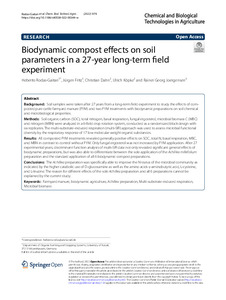| dc.date.accessioned | 2023-04-14T11:01:14Z | |
| dc.date.available | 2023-04-14T11:01:14Z | |
| dc.date.issued | 2022-10-27 | |
| dc.identifier | doi:10.17170/kobra-202304147815 | |
| dc.identifier.uri | http://hdl.handle.net/123456789/14585 | |
| dc.description.sponsorship | Gefördert durch den Publikationsfonds der Universität Kassel | ger |
| dc.language.iso | eng | |
| dc.rights | Namensnennung 4.0 International | * |
| dc.rights.uri | http://creativecommons.org/licenses/by/4.0/ | * |
| dc.subject | Farmyard manure | eng |
| dc.subject | biodynamic agriculture | eng |
| dc.subject | Achillea preparation | eng |
| dc.subject | Multi-substrate-induced respiration | eng |
| dc.subject | Microbial biomass | eng |
| dc.subject.ddc | 570 | |
| dc.subject.ddc | 630 | |
| dc.title | Biodynamic compost effects on soil parameters in a 27-year long-term field experiment | eng |
| dc.type | Aufsatz | |
| dcterms.abstract | Background
Soil samples were taken after 27 years from a long-term field experiment to study the effects of composted pure cattle farmyard manure (FYM) and two FYM treatments with biodynamic preparations on soil chemical and microbiological properties.
Methods
Soil organic carbon (SOC), total nitrogen, basal respiration, fungal ergosterol, microbial biomass C (MBC) and nitrogen (MBN) were analyzed in a 6-field crop rotation system, conducted as a randomized block design with six replicates. The multi-substrate-induced respiration (multi-SIR) approach was used to assess microbial functional diversity by the respiratory response of 17 low molecular weight organic substances.
Results
All composted FYM treatments revealed generally positive effects on SOC, total N, basal respiration, MBC, and MBN in contrast to control without FYM. Only fungal ergosterol was not increased by FYM application. After 27 experimental years, discriminant function analysis of multi-SIR data not only revealed significant general effects of biodynamic preparations, but was also able to differentiate between the sole application of the Achillea millefolium preparation and the standard application of all 6 biodynamic compost preparations.
Conclusions
The Achillea preparation was specifically able to improve the N status of the microbial community as indicated by the higher catabolic use of D-glucosamine as well as the amino acids γ-aminobutyric acid, L-cysteine, and L-leucine. The reason for different effects of the sole Achillea preparation and all 6 preparations cannot be explained by the current study. | eng |
| dcterms.accessRights | open access | |
| dcterms.creator | Rodas Gaitán, Heberto | |
| dcterms.creator | Fritz, Jürgen | |
| dcterms.creator | Dahn, Christian | |
| dcterms.creator | Köpke, Ulrich | |
| dcterms.creator | Jörgensen, Rainer Georg | |
| dc.relation.doi | doi:10.1186/s40538-022-00344-w | |
| dc.subject.swd | Biologische Landwirtschaft | ger |
| dc.subject.swd | Biomasse | ger |
| dc.subject.swd | Bauernhof | ger |
| dc.subject.swd | Düngung | ger |
| dc.subject.swd | Langzeitversuch | ger |
| dc.subject.swd | Feldversuch | ger |
| dc.subject.swd | Schafgarbe | ger |
| dc.type.version | publishedVersion | |
| dcterms.source.identifier | eissn:2196-5641 | |
| dcterms.source.journal | Chemical and Biological Technologies in Agriculture | eng |
| dcterms.source.volume | Volume 9 | |
| kup.iskup | false | |
| dcterms.source.articlenumber | Article-number: 74 | |


